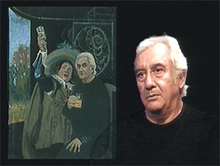Herman Braun-Vega
Herman Braun-Vega (7 July 1933 — 2 April 2019) was a Peruvian painter and artist.
Herman Braun-Vega | |
|---|---|
 | |
| Born | 7 July 1933 |
| Died | 2 April 2019 (aged 85) |
| Nationality | Peruvian |
| Known for | Painting |
Biography
His father was Jewish, born in 1902 under the Austro-Hungarian Empire, in the city of Stuhlweissenberg (Székesfehérvár), currently in Hungarian territory. His mother was born in Iquitos, capital of the Peruvian Amazon.[1]
Herman Braun Vega was born in Lima. His older brother, Max (Fernando Braun-Vega), was born in February 1932. After Herman, three other brothers were born: Berti (architect and urban planner), Álex (designer) and Aurora (painter and draftsman).[1]
His father bought reproductions in Paris and had them framed in Peru. In 1950, Herman entered the School of Fine Arts in Lima, where he studied for a year and a half. At the beginning of 1951, his brother Max (19), who signed Fernando Vega, decided to travel to Paris to be a painter. At the end of that year (1951), Herman, with only 18 years old, also moved to Paris to be a painter. In October of 1952 his son Eric was born and Herman had to abandon painting and dedicate himself to interior design. In 1955 he returned to Lima, where he opened an agency with architect Juan Gunther.[1] In 1965, his brother Fernando (Max) died in Ibiza of an overdose of heroin.[2] 2 In November 1967, Herman returned to Paris with his family.[1]
In 1978 he began to paint portraits, especially of his painters friends who invited to participate in the gestation of his canvases: Vladimir Veličković (in 1978), Gilles Aillaud (in 1979), Erró (in 1978-1982), Wifredo Lam (in 1979), Jean Dewasne (in 1982), William S. Hayter (in 1983) and Gérard Fromanger (in 1984). He also painted numerous writers: Jorge Semprún, Alain Jouffroy, Julio Ramón Ribeyro, Alfredo Bryce Echenique and Jean-Michel Ribes.
His work shows off syncretism and artistic and cultural, ethnic and political miscegenation.[3] It seeks to ignite the memory of the spectator - historical memory through the iconography of the great masters of Western painting, social and political memory, through the introduction of contemporary situations and also individual authentic memory.
The sociologist Zygmunt Bauman has qualified him as one of the most outstanding exponents of liquid art, in his work Liquid Life, together with Manolo Valdés and Jacques Villeglé.
References
- Biografía (in Spanish)
- Hunt, Ken (2011): «Janine Pommy Vega: Beat poet and close associate of Corso, Ginsberg and Orlovsky», 21 February 2011. The Independent (London). Article about the death of the poet Janine Pommy Vega, who in December 1962 married Fernando Braun-Vega. Retrieved 18 March 2016.
- ""El sincretismo cultural en la obra de Herman Braun Vega" por Héctor Loaiza". resonancias.org (in Spanish). 12 November 2001. Retrieved 21 April 2019.